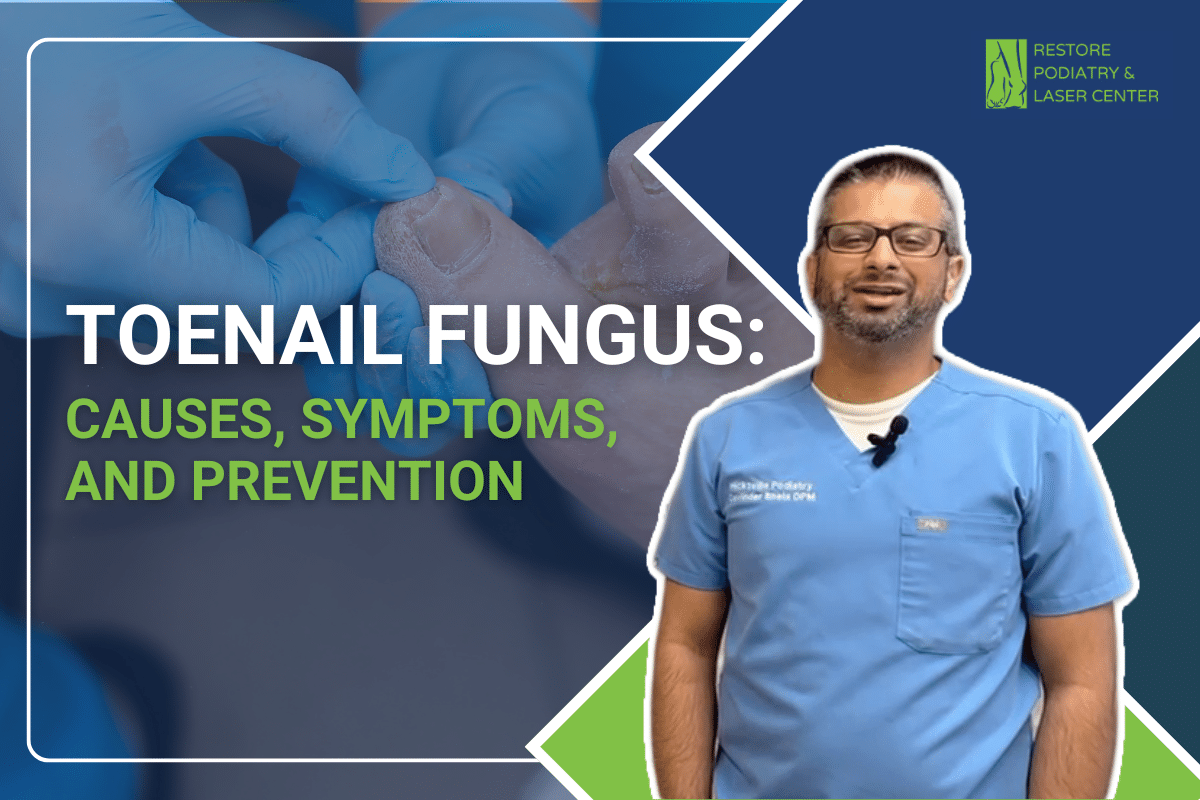Toenail Fungus: Causes, Symptoms, and Prevention

Fungus are commonly found on the body. However, when they overgrow, they result in fungal infections. Toenail fungus infection is a common nail disease that usually occurs as thickening and discoloration of the nail, as well as crumbling edges. According to this study, about 10% of the world’s adult population is infected by nail fungus. Changes in the toenails can cause people to think they have a nail fungal infection, medically called tinea unguium or onychomycosis.
Many individuals believe that toenail fungus is a contagious disease related to poor hygiene. But this isn’t the whole truth. This study showed that 14% of adults in Western countries have a toenail fungus infection, and this percentage increases to 20% of adults aged 60 and above. Toenail fungus is not untreatable. There are various treatments, such as laser treatment, for those who don’t prefer oral medication, drugs, and other treatments with side effects.
In this blog, we will explore toenail fungus, its causes, symptoms, and prevention so that individuals can properly understand toenail fungal infections and consult with doctors to determine the best treatment option.
What Is a Toenail Fungus Infection?
Toenail fungus infection is a condition that leaves an individual with a discolored and brittle toenail. It is called onychomycosis and is quite similar to an athlete’s foot. However, it doesn’t affect the skin between the toes or bottom of your feet. Instead, it affects your nails. Fungi are small organisms only seen via a microscope. Several types of fungi cause nail infections. They can live on your skin and not cause infections, but when there is a lot in a specific area, it might result in an infection. You shouldn’t be embarrassed when you have a toenail fungus. It is quite common.
Causes of Toenail Fungus Infection
Many individuals often think that toenail fungus is highly contagious. Individuals can get a toenail fungus infection when there is a crack in their nail or the skin surrounding it. This crack lets in fungus, which then grows. Fungus thrives in warm and dark places. Therefore, the chances of getting a toenail infection are higher than a fingernail.
Additionally, the toes have less blood flow than the fingers, making it harder for the body to detect and prevent the infection. You can get a toenail infection if you:
- Are a man
- Have health issues such as diabetes and a weak immune system
- Wear shoes that make the feet sweaty and hot
- Are older since nails become fragile and crackable with age
- Have athlete’s foot since the fungus results in it could spread to your nails
- Live with people having fungal infection
- Walk barefooted through swimming pools, gym showers, locker rooms, and other places where it easily spreads.
- You had a previous infection on your nail, undergone surgery, or have an injury.
Symptoms of Toenail Infection Infection
Toenail fungal infections are common cosmetic concerns. However, some people can experience discomfort and pain, which can be aggravated by improper nail trimming, activity, and footwear. Several species of fungi cause toenail fungus. Trichophyton mentagrophytes and Trichophyton rubrum are common fungi that infect the dermatophytes and cause about 80 to 90% of the reported cases.
To know if you have a toenail fungus, check if there are:
- Yellow, thickened, cracked toenails.
- Misshapen toenails
- Smelly
- Separation from the nail bed
Note that having diabetes can prevent you from knowing if you have a toenail fungus. Therefore, always check your nails daily. Additionally, nail fungus affects the fingernails, but it is more commonly found in toenails.
Preventing Toenail Infection
Preventing toenail fungus infection can be as simple as making some lifestyle changes. For example, cleaning and trimming your nails can help prevent infections. Additionally, try avoiding injuries to the skin around your nails. Wear open-toed shoes or sandals when walking around a swimming pool or wet environment. Other ways of prevention include
- Wash your hands and legs after touching infected nails.
- Dry your feet after you shower, especially between the toes.
- Consider getting a pedicure and manicure from a professional.
- Don’t go barefoot in the wet in public places.
- And reduce artificial nail polish and nails.
How To Cure Toenail Fungus
Treating toenail infections usually begins with the podiatrist or dermatologist trimming the infected nails and cutting the infected nail to where it is attached to your toe or finger. The specialist might also scrape away the debris under the nail, removing some of the fungus. To treat toenail infection, most individuals will require one or more of the following:
1. Laser therapy
Laser therapy is used to treat toenail fungus. When used, the laser is pointed so the heat penetrates the nail bed where the fungus resides. The infected tissue, in response to the heat, turns into gas and breaks down, destroying the fungus and the surrounding nails and skin. Additionally, the heat sterilizes the location, preventing new fungal growth. When safely used, laser treatment doesn’t use enough energy to destroy every infected tissue in one go. This is why there are repeat treatments in about four seasons to totally remove the nail fungus.
2. Medicine
When the infection is mild, you can apply medicine to eliminate the infection. The treatment prevents new fungus from entering the nail while it grows. Toenails usually take about 12 to 18 months to regrow. Some FDA-approved medicines for treating toenail fungus include Amorolfine, Ciclopirox, Efinaconazole, and Tavaborole. However, note that there are mild side effects.
Aside from the above, there are more aggressive treatments for nail fungus, such as antifungal pills. They work faster than medicine applied directly to the nail. Some FDA-approved systemic medicines include Fluconazole, Griseofulvin, Itraconazole, and Terbinafine.
4. Nail removal
For severe toenail infections, and other treatments don’t work, podiatrists can sometimes suggest removing the toenails to eliminate the infection. Some of the techniques used in removing the nails include surgical nail removal and non-surgical removal using chemicals applied to the nail.
5. Clear Nail Program
To deal with a toenail fungus infection, experts at Restore Podiatry use deep-tissue laser therapy to destroy toenail fungus. However, before an individual can undergo this therapy, they must pass through a detailed evaluation, allowing the experts to find the right approach and customize the healing plan.
Conclusion
Several microorganisms can result in various types of toenail fungus. When fungus enters your toenail through a crack in your nail, it can spread, resulting in an infection. Treating toenail fungus at home is quite hard. But you can consult with a doctor to find the best treatment for you. Additionally, you can prevent toenail fungus by ensuring your feet are clean and be aware of causes and risk factors. If you are looking to learn about toenail fungus and or considering toenail fungus treatment with laser, this website has all the answers you may need.
Related Questions
1. Is toenail fungus contagious?
Yes, toenail fungus can be found in some places. It can be spread from one person to another via direct contact. Additionally, it can also be transmitted when you touch an infected nail surface.
2. When should I get treatment for toenail fungus?
It is important to see a doctor if self-care steps don’t have an effect when you experience pain and discomfort and if the nail increasingly becomes thickened and discolored. Additionally, if you have diabetes and think you are infected with toenail fungus, then consult with a doctor.
3. What permanently kills toenail fungus?
Laser therapy has an increased ability to remove toenail fungus permanently. For those who want treatment without drugs, injections, and surgeries, laser therapy treatment is an excellent option. It is a minimally invasive and painless treatment that uses low-level laser light to treat fungus and requires a minimum of 4 12-minute sessions applied to the infected area for a mild infection.
